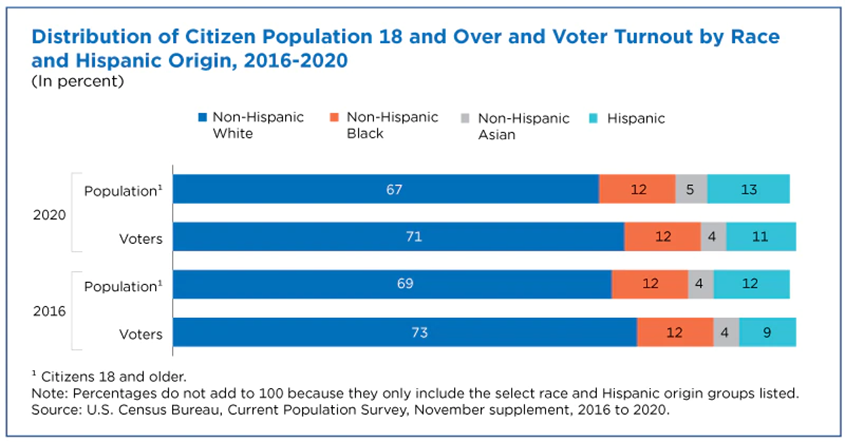How Race Politics Misses the Mark for Latino Voters
As the time winds down for midterm elections for November 8, there remains much uncertainty around Latino voter turnout. The Latino vote this election is crucial, especially considering the impact the Latino vote had on last term’s elections. In the 2020 elections, the number of Latino votes were approximately 16.5 million, tremendous 29.8% increase from the 2016 election, which had 12.7 million Latino votes.
Recent Latino voter turnout has been the highest in years, which signifies their astronomical population growth and increased participation in voting. More than half of eligible Latinos voted in 2020, which was a historical first.

1Latino growing participation has proven to have a significant impact on electoral outcomes. They currently make up 10% of the voting pool in the U.S.2 At the state level, the Latino vote has played an integral role in the election of major upsets like Governor Glenn Youngkin’s victory in Virginia and Congresswomen Mayra Flores’s victory in Texas, which is uncommon to the typical blue voting behavior that Latinos in the U.S. typically portray. Rather than a unified bloc, Latinos should be approached as swing voters with no real loyalties to neither Democrats nor Republicans for the 2022 midterm election.
For decades politicians have fell under the fallacious tendency of assuming that the general Latino population is loyal to a political party, which kept politicians from gauging real concerns of most Latino voters. This transcends is to say, the theory of race politics that assumed that Latinos, like other racial groups, are a homogeneous group with the same interests and norms. this notion is simply not true. In fact, race politics simplifies complex racial groups into theoretical monolithic groups that exist in the media and academic but less in reality.
This misunderstanding has estranged some members of Congress from their Latino voter base. Steeped in stereotypical race memes, they lack basic knowledge around their constituents’ real interests and concerns.
Even the language used by politicians and their media backers misses reality. There’s the frequent use of “Latinx” amongst politicians in Congress but research from found that 1 in four congress members frequently used the term Latinx in the 116th congress, but among Latinos, according to Pew Research, only 3% of Latinos use the term, while 76% have never even heard the term.3 If representatives were serious about winning the Latino Vote, then they might wish to communicate with Latinos with labels they would embrace. It shouldn’t have to take a linguist to point out some of the major flaws of gender neutralizing a term rooted in romantic language.
Rather than becoming more separate, the growing Latino population is becoming more and more representative of the United States population. Research from Pew has shown that Latinos are becoming less engaged with issues that are considered “Latino”, such as immigration rights and citizenship processes. Like most of the country, they are concerned with the economy and quality education for children.4 In reality, the Latino vote is certainly unpredictable, which is holding more representatives accountable for constituency engagement. The best way to appeal to them is not race-centric but around household issues, crime and education. Like pretty much most Americans outside the very rich and very poor.
1 From “Latino Voter Registration and Participation Rates in the 2020 Presidential Election” by L. Bergad & L. Miranda, Center for Latin American , Caribbean, and Latino Studies
2 https://www.wsj.com/articles/latino-voters-republican-midterm-elections-11663166135
3 From “About One-in-Four U.S. Hispanics Have Heard of Latinx, but Just 3% Use it” by L. Noe-Bustamante et al., 2020. Pew Research Center
4 https://www.state.gov/briefings-foreign-press-centers/midterm-elections-latino-voters
Graph: Census Bureau





 Terry Hammonds, CC 2.0 License
Terry Hammonds, CC 2.0 License

